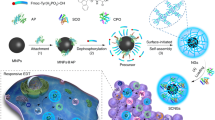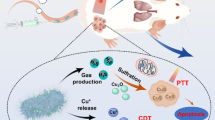Abstract
Tumor-targeting attenuated Salmonella could induce certain antitumor therapeutic effect through its proliferation characteristic and the consequent activated immune response, while host defense cells represented by neutrophils would trap and eliminate these invading bacteria via producing excess hydrogen peroxide (H2O2)-including reactive oxygen species in the bacteria-infected tumor, thereby impairing the efficacy of the bacteria treatment of tumor. Herein, we attempt to combine bacteria treatment and oxygen-dependent radioimmunotherapy of tumor through injection of neutrophil-targeted nano-catalase into the bacteria-treated mice for perfect tumor treatment outcome. Denatured albumin is used to coat catalase and deliver it to the neutrophils infiltrated in bacteria-infected tumor tissue. Taking advantage of the generating H2O2 by neutrophils, easily-diffused oxygen is produced and spread the whole tumor under the catalysis of nano-enzyme, leading to enhanced radiotherapy of hypoxic tumor cells. Moreover, the optimized tumor microenvironment, synergistically caused by potent immune-stimulation of bacteria, generating oxygen and tumor radiotherapy, would boost the antitumor immunity. This novel combination therapy strategy holds great promise to provide new ideas for future clinical cancer treatment.

Similar content being viewed by others
References
Seong, S. Y.; Matzinger, P. Hydrophobicity: An ancient damage-associated molecular pattern that initiates innate immune responses. Nat. Rev. Immunol. 2004, 4, 469–478.
Amarante-Mendes, G. P.; Adjemian, S.; Branco, L. M.; Zanetti, L. C.; Weinlich, R.; Bortoluci, K. R. Pattern recognition receptors and the host cell death molecular machinery. Front. Immunol. 2018, 9, 2379.
De Lorenzo, G.; Ferrari, S.; Cervone, F.; Okun, E. Extracellular DAMPs in plants and mammals: Immunity, tissue damage and repair. Trends Immunol. 2018, 39, 937–950.
Kono, H.; Rock, K. L. How dying cells alert the immune system to danger. Nat. Rev. Immunol. 2008, 8, 279–289.
Hernandez, C.; Huebener, P.; Schwabe, R. F. Damage-associated molecular patterns in cancer: A double-edged sword. Oncogene 2016, 35, 5931–5941.
Gontero, P.; Bohle, A.; Malmstrom, P. U.; O’Donnell, M. A.; Oderda, M.; Sylvester, R.; Witjes, F. The role of bacillus Calmette-Guérin in the treatment of non-muscle-invasive bladder cancer. Eur. Urol. 2010, 57, 410–429.
Raja, J.; Ludwig, J. M.; Gettinger, S. N.; Schalper, K. A.; Kim, H. S. Oncolytic virus immunotherapy: Future prospects for oncology. J. Immunother. Cancer 2018, 6, 140.
Yang, Z. J.; Zhu, Y. J.; Dong, Z. L.; Hao, Y.; Wang, C. J.; Li, Q. G.; Wu, Y. M.; Feng, L. Z.; Liu, Z. Engineering bioluminescent bacteria to boost photodynamic therapy and systemic anti-tumor immunity for synergistic cancer treatment. Biomaterials 2021, 281, 121332.
Toso, J. F.; Gill, V. J.; Hwu, P.; Marincola, F. M.; Restifo, N. P.; Schwartzentruber, D. J.; Sherry, R. M.; Topalian, S. L.; Yang, J. C.; Stock, F. et al. Phase I study of the intravenous administration of attenuated Salmonella typhimurium to patients with metastatic melanoma. J. Clin. Oncol. 2002, 20, 142–152.
Wall, D. M.; Srikanth, C. V.; McCormick, B. A. Targeting tumors with Salmonella typhimurium-potential for therapy. Oncotarget 2010, 1, 721–728.
Zhou, S. B.; Gravekamp, C.; Bermudes, D.; Liu, K. Tumour-targeting bacteria engineered to fight cancer. Nat. Rev. Cancer 2018, 18, 727–743.
Bjarnsholt, T.; Whiteley, M.; Rumbaugh, K. P.; Stewart, P. S.; Jensen, P. Ø., Frimodt-Møller, N. The importance of understanding the infectious microenvironment. Lancet Infect. Dis. 2022, 22, e88–e92.
Westphal, K.; Leschner, S.; Jablonska, J.; Loessner, H.; Weiss, S. Containment of tumor-colonizing bacteria by host neutrophils. Cancer Res. 2008, 68, 2952–2960.
Winterbourn, C. C.; Kettle, A. J.; Hampton, M. B. Reactive oxygen species and neutrophil function. Annu. Rev. Biochem. 2016, 85, 765–792.
Galdiero, M. R.; Garlanda, C.; Jaillon, S.; Marone, G.; Mantovani, A. Tumor associated macrophages and neutrophils in tumor progression. J. Cell. Physiol. 2013, 228, 1404–1412.
Chu, D. F.; Dong, X. Y.; Zhao, Q.; Gu, J. K.; Wang, Z. J. Photosensitization priming of tumor microenvironments improves delivery of nanotherapeutics via neutrophil infiltration. Adv. Mater. 2017, 29, 1701021.
Mohanty, T.; Fisher, J.; Bakochi, A.; Neumann, A.; Cardoso, J. F. P.; Karlsson, C. A. Q.; Pavan, C.; Lundgaard, I.; Nilson, B.; Reinstrup, P. et al. Neutrophil extracellular traps in the central nervous system hinder bacterial clearance during pneumococcal meningitis. Nat. Commun. 2019, 10, 1667.
Mi, Z.; Guo, L. N.; Liu, P.; Qi, Y.; Feng, Z. C.; Liu, J. H.; He, Z. H.; Yang, X.; Jiang, S. N.; Wu, J. Z. et al. “Trojan horse” Salmonella enabling tumor homing of silver nanoparticles via neutrophil infiltration for synergistic tumor therapy and enhanced biosafety. Nano Lett. 2020, 21, 414–423.
Chen, X. F.; Song, J. B.; Chen, X. Y.; Yang, H. H. X-ray-activated nanosystems for theranostic applications. Chem. Soc. Rev. 2019, 48, 3073–3101.
Fan, W. P.; Tang, W.; Lau, J.; Shen, Z. Y.; Xie, J.; Shi, J. L.; Chen, X. Y. Breaking the depth dependence by nanotechnology-enhanced X-ray-excited deep cancer theranostics. Adv. Mater. 2019, 31, 1806381.
Liu, Y.; Dong, Y. P.; Kong, L.; Shi, F.; Zhu, H.; Yu, J. M. Abscopal effect of radiotherapy combined with immune checkpoint inhibitors. J. Hematol. Oncol. 2018, 11, 104.
Arina, A.; Gutiontov, S. I.; Weichselbaum, R. R. Radiotherapy and immunotherapy for cancer: From “systemic” to “multisite”. Clin. Cancer Res. 2020, 26, 2777–2782.
Rockwell, S.; Dobrucki, I. T.; Kim, E. Y.; Marrison, S. T.; Vu, V. T. Hypoxia and radiation therapy: Past history, ongoing research, and future promise. Curr. Mol. Med. 2009, 9, 442–458.
Grimes, D. R.; Partridge, M. A mechanistic investigation of the oxygen fixation hypothesis and oxygen enhancement ratio. Biomed. Phys. Eng. Express 2015, 1, 045209.
Dai, Y. L.; Xu, C.; Sun, X. L.; Chen, X. Y. Nanoparticle design strategies for enhanced anticancer therapy by exploiting the tumour microenvironment. Chem. Soc. Rev. 2017, 46, 3830–3852.
Chen, H. C.; Tian, J. W.; He, W. J.; Guo, Z. J. H2O2-activatable and O2-evolving nanoparticles for highly efficient and selective photodynamic therapy against hypoxic tumor cells. J. Am. Chem. Soc. 2015, 137, 1539–1547.
Song, X. J.; Xu, J.; Liang, C.; Chao, Y.; Jin, Q. T.; Wang, C.; Chen, M. W.; Liu, Z. Self-supplied tumor oxygenation through separated liposomal delivery of H2O2 and catalase for enhanced radio-immunotherapy of cancer. Nano Lett. 2018, 18, 6360–6368.
Zhang, R.; Song, X. J.; Liang, C.; Yi, X.; Song, G. S.; Chao, Y.; Yang, Y.; Yang, K.; Feng, L. Z.; Liu, Z. Catalase-loaded cisplatin-prodrug-constructed liposomes to overcome tumor hypoxia for enhanced chemo-radiotherapy of cancer. Biomaterials 2017, 138, 13–21.
Xu, B. L.; Cui, Y.; Wang, W. W.; Li, S. S.; Lyu, C. L.; Wang, S.; Bao, W. E.; Wang, H. Y.; Qin, M.; Liu, Z. et al. Immunomodulation-enhanced nanozyme-based tumor catalytic therapy. Adv. Mater. 2020, 32, 2003563.
Wang, W. Q.; Jin, Y. L.; Liu, X.; Chen, F. M.; Zheng, X. H.; Liu, T. Q.; Yang, Y. M.; Yu, H. J. Endogenous stimuli-activatable nanomedicine for immune theranostics for cancer. Adv. Funct. Mater. 2021, 31, 2100386.
Wang, Z. J.; Li, J.; Cho, J.; Malik, A. B. Prevention of vascular inflammation by nanoparticle targeting of adherent neutrophils. Nat. Nanotechnol. 2014, 9, 204–210.
Yang, Z. Z.; Du, Y. T.; Sun, Q.; Peng, Y. W.; Wang, R. D.; Zhou, Y.; Wang, Y. Q.; Zhang, C. L.; Qi, X. R. Albumin-based nanotheranostic probe with hypoxia alleviating potentiates synchronous multimodal imaging and phototherapy for glioma. ACS Nano 2020, 14, 6191–6212.
Chu, D. F.; Gao, J.; Wang, Z. J. Neutrophil-mediated delivery of therapeutic nanoparticles across blood vessel barrier for treatment of inflammation and infection. ACS Nano 2015, 9, 11800–11811.
Segal, A. W.; Abo, A. The biochemical basis of the NADPH oxidase of phagocytes. Trends Biochem. Sci. 1993, 18, 43–47.
Niesel, K.; Schulz, M.; Anthes, J.; Alekseeva, T.; Macas, J.; Salamero-Boix, A.; Möckl, A.; Oberwahrenbrock, T.; Lolies, M.; Stein, S. et al. The immune suppressive microenvironment affects efficacy of radio-immunotherapy in brain metastasis. EMBO Mol. Med. 2021, 13, e13412.
Wang, W. G.; Xu, H. H.; Ye, Q. S.; Tao, F.; Wheeldon, I.; Yuan, A.; Hu, Y. Q.; Wu, J. H. Systemic immune responses to irradiated tumours via the transport of antigens to the tumour periphery by injected flagellate bacteria. Nat. Biomed. Eng. 2022, 6, 44–53.
Duong, M. T. Q.; Qin, Y. S.; You, S. H.; Min, J. J. Bacteria-cancer interactions: Bacteria-based cancer therapy. Exp. Mol. Med. 2019, 51, 1–15.
Borregaard, N. What doesn’t kill you makes you stronger: The antiinflammatory effect of neutrophil respiratory burst. Immunity 2014, 40, 1–2.
Rolas, L.; Makhezer, N.; Hadjoudj, S.; El-Benna, J.; Djerdjouri, B.; Elkrief, L.; Moreau, R.; Périanin, A. Inhibition of mammalian target of rapamycin aggravates the respiratory burst defect of neutrophils from decompensated patients with cirrhosis. Hepatology 2013, 57, 1163–1171.
Forman, H. J.; Torres, M. Reactive oxygen species and cell signaling: Respiratory burst in macrophage signaling. Am. J. Respir. Crit. Care. Med. 2002, 166, S4–S8.
McCoy, K. D.; Ronchi, F.; Geuking, M. B. Host-microbiota interactions and adaptive immunity. Immunol. Rev. 2017, 279, 63–69.
Saccheri, F.; Pozzi, C.; Avogadri, F.; Barozzi, S.; Faretta, M.; Fusi, P.; Rescigno, M. Bacteria-induced gap junctions in tumors favor antigen cross-presentation and antitumor immunity. Sci. Transl. Med. 2010, 2, 44ra57.
Caamaño, J.; Hunter, C. A. NF-κB family of transcription factors: Central regulators of innate and adaptive immune functions. Clin. Microbiol. Rev. 2002, 15, 414–429.
Duque, G. A.; Descoteaux, A. Macrophage cytokines: Involvement in immunity and infectious diseases. Front. Immunol. 2014, 5, 491.
Riboldi, E.; Porta, C.; Morlacchi, S.; Viola, A.; Mantovani, A.; Sica, A. Hypoxia-mediated regulation of macrophage functions in pathophysiology. Int. Immunol. 2013, 25, 67–75.
Pan, Y. Y.; Yu, Y. D.; Wang, X. J.; Zhang, T. Tumor-associated macrophages in tumor immunity. Front. Immunol. 2020, 11, 583084.
Chen, J. W.; Liang, C.; Song, X. J.; Yi, X.; Yang, K.; Feng, L. Z.; Liu, Z. Hybrid protein nano-reactors enable simultaneous increments of tumor oxygenation and iodine-131 delivery for enhanced radionuclide therapy. Small 2019, 15, 1903628.
Zhang, C. Y.; Dong, X. Y.; Gao, J.; Lin, W. J.; Liu, Z.; Wang, Z. J. Nanoparticle-induced neutrophil apoptosis increases survival in sepsis and alleviates neurological damage in stroke. Sci. Adv. 2019, 5, eaax7964.
Gao, J.; Wang, S. H.; Wang, Z. J. High yield, scalable and remotely drug-loaded neutrophil-derived extracellular vesicles (EVs) for anti-inflammation therapy. Biomaterials 2017, 135, 62–73.
Acknowledgements
This work was partially supported by the National Natural Science Foundation of China (Nos. 32171382, U1932208 U2032134, and 31900986), the Project of State Key Laboratory of Radiation Medicine and Protection, Soochow University (No. GZK1202110), and the Project Funded by the Priority Academic Program Development of Jiangsu Higher Education Institutions (PAPD).
Author information
Authors and Affiliations
Corresponding authors
Electronic Supplementary Material
Rights and permissions
About this article
Cite this article
Ni, J., Zhou, H., Gu, J. et al. Bacteria-assisted delivery and oxygen production of nano-enzyme for potent radioimmunotherapy of cancer. Nano Res. 15, 7355–7365 (2022). https://doi.org/10.1007/s12274-022-4369-4
Received:
Revised:
Accepted:
Published:
Issue Date:
DOI: https://doi.org/10.1007/s12274-022-4369-4




